The USAID and NREL Quarterly Newsletter
November 2023 Edition
In this edition, learn what the 2023 Women in Power System Transformation interns have been up to; explore how multiple partnerships are helping Colombia meet its clean energy and transportation goals; and explore tools, resources, and events from this quarter.
Subscribe to receive this newsletter via email.

Contents
Unlocking the Grid To Accelerate Clean Energy Deployment
Hydrogen Considerations Tree Helps USAID Missions and Partners Make Informed Development Decisions
A Just and Sustainable Transition of Our Transportation Sector Is Possible
Congratulations to the 2023 Women in Power System Transformation Interns
Partnerships Prove Potent in Advancing Colombia's Clean Energy and Transportation Goals
Unlocking the Grid To Accelerate Clean Energy Deployment
Countries around the world continue to set and design inspiring and ambitious policies and targets for renewable energy deployment and large-scale power sector transitions. As solar and wind generation grows rapidly, the electric grids that deliver our energy must undergo transformations to adapt to an evolving energy landscape. Without power systems that can run safely, reliably, and cost-effectively on zero carbon energy sources, the global clean energy transition faces significant barriers.
That is precisely why the USAID-NREL Partnership has prioritized working with utilities, power system operators, regulators, and energy ministries to address their most pressing energy transition concerns and prepare grids around the world to successfully incorporate increasing shares of variable renewable energy.
For example, in 2017 when the government of India laid out a goal to integrate 175 gigawatts (GW) of installed renewable capacity by 2022, it turned to a team of specialists from USAID, NREL, India's power system operator (Grid India), and the Lawrence Berkeley National Laboratory for assistance. This team performed a landmark grid integration study that resolved critical questions about how India's electric grid could manage high penetrations of wind and solar generation.
As of February 2023, having overcome unanticipated challenges related to the global pandemic, India's total installed renewable energy capacity reached 168 GW, and the Indian government has since increased its installed capacity goal to 500 GW by 2030—illustrating strengthened confidence in its ability to operate a high-renewable grid.
Grid integration studies aren't the only proactive measure countries can take to ensure they are ready to deploy more renewables. Together with colleagues in the Philippines, the USAID-NREL Partnership embarked on a transmission planning study, beginning in 2018, that identified the most economic renewable energy resource zones across the country to build out new transmission lines. By focusing transmission expansion to these resource areas, renewable energy development obstacles are easier to overcome, thus reducing risk for private sector investment.
In February 2023, the transmission plan informed by this study was approved by the Philippines government.
Policy successes informed by data-driven analysis are critical to power sector transitions, as we've seen in India and the Philippines. However, building on these successes, grid operation is where the rubber meets the road for actual large-scale integration of variable renewable energy.
A key partner of the USAID-NREL Partnership, the Global Power System Transformation Consortium (G-PST) provides in-depth support and experiential learning opportunities to system operators and utilities around the world at the forefront of implementing operational and engineering solutions to meet this need.
As we hear the growing demand for this type of cutting-edge analysis and support from countries around the world, G-PST and its robust network will continue to offer assistance for grid modeling, tool implementation, and workforce development to USAID Missions and their partners via the USAID-NREL Partnership.
As the director of G-PST as well as lead for the USAID-NREL Partnership's power pillar, I'm excited to draw deeper connections between these two high-impact programs. Together, we can accelerate our progress to a cleaner, brighter energy future.
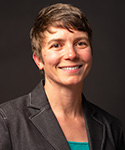
Best,
Karin Wadsack, Ph.D.
Lead for Advanced and Frontier Power System Pillar, USAID-NREL Partnership
Director, G-PST Consortium
Featured News
Hydrogen Considerations Tree Helps USAID Missions and Partners Explore Informed Development
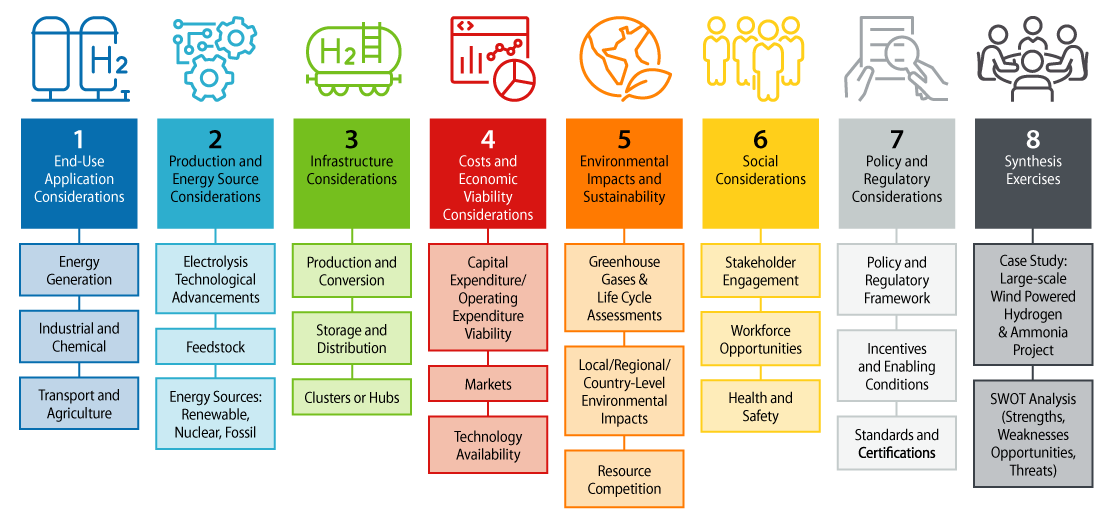
Key topics are organized into a "considerations tree" to help stakeholders think through technical, regulatory, economic, environmental, social, and analytical questions to inform decisions related to hydrogen and its derivatives.
Hydrogen is used in many sectors across our economies. It's used in the transportation sector, refineries, fertilizer production, chemical production, and steel. However, creating hydrogen is an energy-intensive process, and greenhouse gas emissions from hydrogen production vary widely based on the energy sources used to create it.
Hydrogen can be produced via electrolysis using electricity from renewable energy (e.g., wind and solar) or from more conventional production pathways (e.g., steam methane reformation from natural gas). Although using renewable energy sources to reduce greenhouse gas emissions is ideal, electrolysis uses a lot of electricity. Despite this large energy use, low-carbon hydrogen production from solar and wind electrolysis is expected to be competitive with traditional production methods by 2030 or earlier.
The USAID-NREL Partnership created a Hydrogen Considerations Tree to help USAID Missions and country partners explore hydrogen development as they look to potentially support hydrogen production and its derivatives. This resource helps USAID missions and partners build understanding of the key considerations for hydrogen's costs, benefits, and tradeoffs when making strategy, policy, and investment decisions.
Download the Hydrogen Considerations Tree Executive Deck to learn more.
A Just and Sustainable Transition of Our Transportation Sector Is Possible
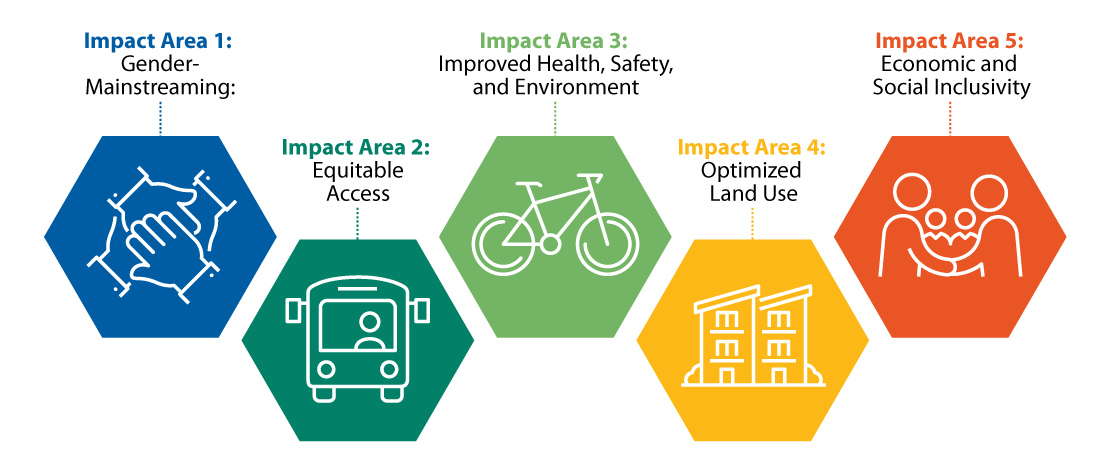
USAID-NREL Partnership's conceptual framework for a just and sustainable mobility transition in the transport sector.
Decades of prioritization of roadways in global transportation infrastructure investments has over-emphasized designing one-size-fits-all public transit systems, resulting in widespread inequities in access, affordability, and reliability of transport options. These inequities have disproportionately impacted women, elderly minorities, and low-income communities. With today's rapid global shift toward decarbonized and low-carbon transport, now is an opportune time to reimagine the world's transport systems through a holistic and sustainable approach, shifting to low- and zero-carbon modes and offering wider access to all segments of the population.
A new report from the USAID-NREL Partnership highlights a just and sustainable mobility transition framework for transport practitioners and policymakers with a focus on gender-mainstreaming considerations. The proposed conceptual framework consists of five key impact areas that will, in the long term, enable just and sustainable mobility transitions in the transport sector.
This publication showcases two regional case studies—from New Delhi, India, and Hermosillo, Mexico—that describe novel pilot projects for introducing gender-inclusive transport options that address local challenges. Both case studies represent new programmatic solutions concerning safety and employment opportunities for women while working toward decarbonizing the transport sector and demonstrating replicable and scalable opportunities.
Read the October 2023 Just and Sustainable Mobility Transition in the Transport Sector: A Conceptual Framework and Gender-Mainstreaming Case Studies.
Congratulations to the 2023 Women in Power System Transformation Interns
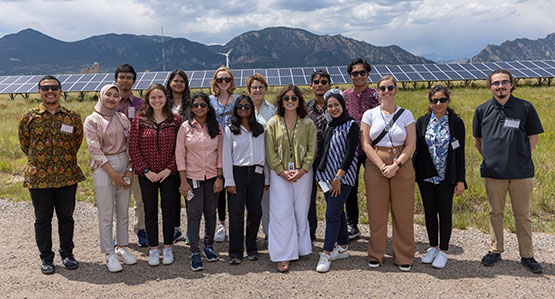
Women in Power System Transformation interns from NREL and the Electric Power Research Institute, along with professional fellows from Indonesia's power system operator, Perusahaan Listrik Negara, toured NREL's Flatirons Campus in August. The program is training the next generation of women and underrepresented groups leading change in the power sector. Photo by Joe DelNero, NREL
We are excited to congratulate the eight students who completed this year's Women in Power System Transformation (PST) internship program. As the 2023 internship concludes, participants are returning home with new technical expertise, professional connections, and more.
The Women in PST internship program is a flagship activity developed by the Women in Power System Transformation initiative. This 4-month internship offers mentorship, research, and leadership training to women and other underrepresented groups who are pursuing technical careers in power system operations.
Working practitioner fellows, all employed at Indonesia's national power utility, Perusahaan Listrik Negara, also spent June through August 2023 at the California Independent System Operator Corp. Women in PST's coordinating team collaborated closely with the practitioner exchange so these mid-career professionals could also engage in the workforce development opportunities and programming offered by Women in PST.
Throughout both respective programs, the student interns and professional fellows contributed to cutting-edge research on power system transformation and had the opportunity to strengthen critical technical competencies through applied problem-solving and analysis. The graduate interns participated in technical and professional training at NREL in Golden, Colorado, and the Electric Power Research Institute, participating remotely from Chicago, Illinois; Boulder, Colorado; Phoenix, Arizona; and Dublin, Ireland.
As a conclusion to the Women in PST program, interns and fellows visited NREL's research and laboratory facilities, engaged in discussions with power sector experts, and took part in the Self-Empowerment and Equity for Change Initiative training. The seminar uses neuroscience and positive psychology to highlight personal agency in overcoming workplace challenges and achieving personal and professional goals.
Join us in congratulating these interns on completing the 2023 Women in PST program and wishing them well on the next steps in their careers. Applications for the 2024 internship program are already open. Apply to be placed at NREL. Keep an eye out for Electric Power Research Institute's applications to open.
Read more about what these interns worked on during the program and how it set them up for success in Women in Power System Transformation Internship Program Is Cultivating a More Equitable Energy Workforce.
Interested in participating in a similar mentorship program? The Women in Power System Transformation Initiative is collaborating with the Global Women's Network for the Energy Transition to launch a joint mentorship program that aims to fast-track the careers of talented women holding junior and mid-level positions in the clean energy and power sectors. The objectives of the joint mentorship program include:
- Elevating the presence of women in leadership and decision-making roles
- Fostering innovation, encouraging fresh perspectives, and promoting valuable networking opportunities
- Providing dedicated support to help participants formulate tangible career aspirations and strategically work toward achieving them.
The program is looking for both mentors and mentees. Applications for both positions are due by Nov. 30, 2023. If you or someone in your network matches the criteria and is enthusiastic about championing a more diverse, inclusive, and forward-thinking energy sector, we encourage you to complete the respective application forms for mentors or mentees.
Partnerships Prove Potent in Advancing Colombia's Clean Energy and Transportation Goals
The USAID-NREL Partnership has been working closely with the Colombian government and other key local, regional, private, and public sector stakeholders to find ways to meet the country's clean energy and transportation goals.
Watch The USAID-NREL Partnership's Colombia Young Leaders Workforce Training Program video to learn more about the workforce development program.
One of the efforts to support Colombia's energy transition came through the USAID-NREL Partnership collaborating with the United States Energy Association and the USAID-funded Scaling Up Renewable Energy, implemented by Tetra Tech, to create a training program. This training helped ready Colombia's energy sector workforce to participate in the construction, operation, and grid integration of variable renewable energy projects. Nearly 60 early-career professionals from more than 20 organizations within the Colombian energy sector participated in the training program. The participant selection process targeted candidates with potential for future leadership roles and included an emphasis on gender diversity and women's involvement, including more than 70% female participation.
From this training, the USAID-NREL Partnership, with help from government stakeholders in Colombia, created a customized version of the Electric Vehicle Infrastructure Projection modeling tool (previously used only in the United States). The government of Colombia has ambitious targets for electric vehicle deployment, with a high concentration of projected electric vehicles and electric vehicle charging infrastructure planned for Bogotá. The Electric Vehicle Infrastructure Projection tool has been adapted to the specific conditions in Bogotá using data from an extensive travel survey conducted in 2019 to model and optimize the future charging demand for the area. With output from the EVI-Pro model, stakeholders in Bogotá can plan for future charging station demand and facilitate a smooth transition to electric mobility.
Read the EVI-Pro for Bogotá Colombia brochure to learn more about how this tool was customized for the city's unique context.
USAID and Lawrence Berkeley National Laboratory Lead Collaborative Workshop To Address Uganda's Critical Energy Challenges and Opportunities
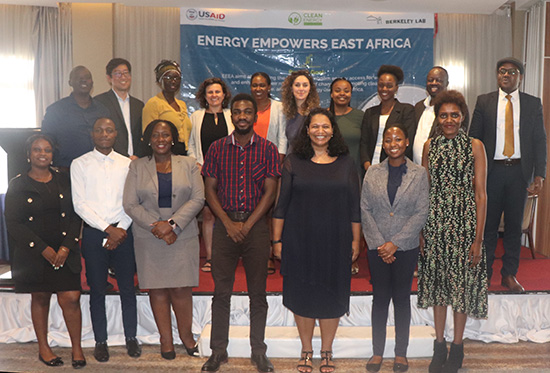
Bridging the gap between current energy practices and the efficient and productive use of energy (PUE) in Uganda is a complex challenge with significant implications for economic growth and the well-being of the population. PUE is critical to improving electrification rates in Uganda, maintaining the transmission and distribution network, and reducing dependence on charcoal. USAID and Lawrence Berkeley National Laboratory are supporting the Government of Uganda to develop a nationwide strategy that addresses finance, affordability, and regulatory needs for improved uptake of PUE equipment.
USAID and Lawrence Berkeley National Laboratory convened a national workshop with the Ministry of Energy and Mineral Development of Uganda in Kampala on July 27 as part of the Energy Empowers East Africa program to build consensus on key PUE challenges. The workshop focused on PUE, energy efficiency, and gender equality, addressing critical energy challenges and opportunities at a country level. More than 80 stakeholders participated, including representatives from ministries, private sector entities, nongovernmental organizations, financial institutions, and local communities. Participants actively explored potential pathways to enhance the efficient and productive use of energy in Uganda, with the goal of increasing efficient energy use to stimulate economic growth and improve livelihoods. The workshop was held during Uganda's revision of the Energy Efficiency and Conservation Bill, which spurred actionable suggestions to enhance electricity use and laid the groundwork for a national strategy to leverage both on-grid and off-grid resources in innovative ways.
The USAID and Lawrence Berkeley National Laboratory research team met with government partners, such as the Ministry of Energy and Mineral Development; the Electricity Regulatory Authority; the largest distribution utility, Umeme; and other local collaborators and stakeholders to share insights and coordinate. In a full week of consultative meetings, the team gathered crucial data on local needs in the PUE sector and heard insights from governmental officials, local experts, and stakeholders into where targeted assistance should be directed. Additionally, the team visited a women-run maize milling business to understand in-ground opportunities for efficient PUE uptake and assess benefits. This set the stage for the program's Phase IV, which will focus on conducting energy audits in medium-sized women-owned businesses, including a cost-benefit analysis tool to understand and develop PUE and energy efficiency investment plans and analyses in specific value chain sectors.
Tools and Resources for Real-World Problem-Solving
We love learning how our tools and resources provide solutions to people, organizations, and even governments around the world. Our team spoke with Ahsan Jalal, a manager at the Institute of Technology Assessment and Transfer at the Pakistan Academy of Engineering about the RE Data Explorer tool. He used RE Data Explorer to determine the potential of solar- and wind-based hydrogen production to design a mobile hydrogen-based life support system in Pakistan. Ahsan shared that he hopes the hydrogen research will help with Pakistan's frequent struggles with devastating floods and earthquakes and provide a system to help those that need a consistent supply of clean water and energy in these critical situations.
"I'd like to thank the NREL team for providing such high-quality and reliable data to everyone, which we can use freely … a very deep thank you."—Ashan Jalal, Manager, Institute of Technology Assessment and Transfer, The Pakistan Academy of Engineering
Meet the Team: Kwami Sedzro
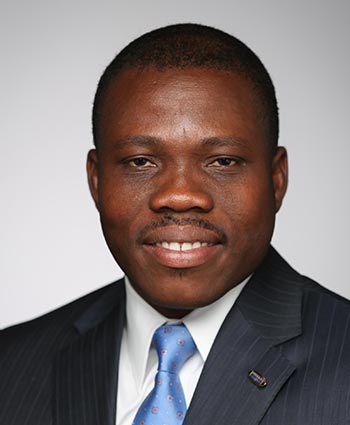
Kwami Sedzro is a senior engineer in NREL's Transmission and Distribution Interactions group in the Grid Planning and Analysis Center. He serves as subject matter expert and partner manager on international partnerships and initiatives aimed at accelerating renewable grid integration and energy access. He currently leads USAID-NREL Partnership initiatives in Ghana and Tanzania, and a Net Zero World Initiative in Nigeria. In the United States, he supports other initiatives such as the LA100 Equity Strategies.
How did you decide on a career path in power systems?
I came to power systems through a unique encounter. Growing up in a small village in southern Togo, we had no access to electricity. I came home from school one day after it was already dark. For light, I had to grope for a candle and a match in the dark room, but when I lit the candle, I was terrified by the sight of a python snake on my bed. I wondered what would have happened if it had been on the table where I left my candle. From that day forward, I began to gather used batteries from my dad's radio to assemble electrical circuits for lighting in my room. That's how I developed a passion for electricity, which continues to drive me.
What first inspired you to work on international projects through the USAID-NREL Partnership?
Two things got me excited about international projects. First, having been through childhood without electricity, I understand what people go through in developing countries where access to reliable energy is a challenge. Second, my first proposed international project had a special focus. It aimed to build technical capacity in a country located in West Africa, my region of origin. As a Fulbright alumnus, I saw this project as an opportunity to give back to my community. So I embraced it right away. Five years later, I am still enjoying working on international projects. Seeing first-hand how NREL's leadership in renewable integration and energy access impacts lives overseas is a thrilling experience. Every time I see utility engineers' eyes light up at some defining moments during my capacity-building workshops, my commitment to these projects reaches another level.
What is a USAID-NREL Partnership project that you are really excited about right now and why?
It is not easy to pick one because I really enjoy working with all the energy industry stakeholders I have interacted with these past 5 years. However, the one I am really excited about right now is the Non-Wires Alternative project with the transmission system operator, Ghana Grid Co. I am excited about this project because it offers me the opportunity to bring a major change into this transmission system operator's practice. Before this assignment, the utility only looked at wire solutions when a persistent network constraint occurred. But now, they systematically look at other solution options, including renewable energy solutions, when network upgrades are needed. This is a major step in the country's energy transition because it has removed a major adoption barrier and shaped their view of renewable energy. Renewable energy assets are no longer seen as operational challenges but as assets that can help defer or replace expensive investments. I am happy to be part of that major mindset shift.
Why is it important to work with other countries around the world on deploying advanced and sustainable power systems?
For one thing, working with other countries around the world on deploying advanced and sustainable power systems is a way to continue affirming the United States' leadership in the green energy transition. Further, our international work helps transfer knowledge and technology to developing countries to accelerate a more global approach to sustainable development goals. The truth is that if we are to make this planet a better place from a climate point of view, no country should be left behind. Our international work at NREL is critical at pulling every country we work with into the conversation about how we can all best achieve these goals.
If you could give any advice to young or early-career researchers or persons in the energy systems field, what would it be?
Never stick with a project that you cannot learn anything from. It's a waste of your time. One thing I like at NREL, and especially in my international assignments, is the permanent challenge of adapting to local practices and unique circumstances. We do not copy and paste solutions. Every country is different, so I do my best to ensure that my team can respond to each country's needs instead of pasting solutions from other countries.
Finally, tell us a little bit about yourself. How do you like to spend your time outside of work?
Outside of work I enjoy spending time with my family playing soccer, tennis, and chess. We often have discussions about where technology is going and which area they would like to embrace. I also love learning new skills and reading.
Resource Round-Up
Must-Reads
International Cybersecurity: Capabilities and Overview, NREL Presentation (2023)
Innovations in clean energy technology are beginning to transform electric grids
around the world. It is more important than ever to understand and improve the resiliency
and security of the grid against natural and human disruptions as our energy systems
become more distributed, intelligent, and interconnected. Through its advanced cybersecurity
technical assistance portfolio, experts at the National Renewable Energy Laboratory
work with international governments to support secure and resilient deployment of
renewable energy assets and address grid interconnection challenges. These complementing
resources showcase the cybersecurity technical assistance and tools available to NREL's
international partners.
Advancing Global Cybersecurity, NREL Fact sheet (2023)
Hydrogen Considerations Tree Executive Deck, NREL Presentation (2023)
EVI-Pro for Bogotá Colombia, Brochure (2023)
Just and Sustainable Mobility Transition in the Transport Sector: A Conceptual Framework and Gender-Mainstreaming Case Studies, NREL Technical Report (2023)
Must Watch
The USAID-NREL Partnership's Colombia Young Leaders Workforce Training Program
Share
